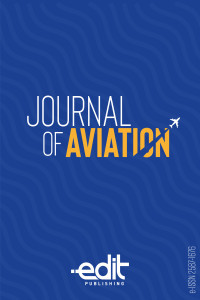Yatay Kuyruklarda Kıvrık Kanat Ucu Kullanımının Aerodinamik Etkileri
Yatay Dengeleyici, Kıvrık Kanat Ucu, NACA 0012, HAD
The Aerodynamic Effects of The Using Curved Wingtip Devices on Horizontal Tail
Horizontal Stabilizer, Curved Wingtip Devices (Winglet), NACA 0012, CFD,
___
- [1] Tyler T. (2016). ''International Air Transport Association Annual Review,'' 72nd Annual General Meeting, Dublin.
- [2] Maughmer, D. M. (2001). The Design of Winglets for High-Performance Sailplanes, The American Institute of Aeronautics and Astronautics, 2406, 1-11.
- [3] Maughmer, D. M., Swan, T. S., Willits, S. M. (2001). The Design and Testing of a Winglet Airfoil for Low-Speed Aircraft, The American Institute of Aeronautics and Astronautics, 2478, 1-10.
- [4] Menter, F. R., Kuntz, M., Langtry, R. (2003). Ten Years of Industrial Experience with the SST Turbulence Model, Turbulence, Heat and Mass Transfer, 4, 1-8.
- [5] Nicolosi, F., Marco, A. D., Vecchia, P. D. (2011). Flight Tests, Performance, and Flight Certification of a Twin-Engine Light Aircraft, Journal of Aircraft, 48 (1), 177-192.
- [6] Curry, M (2008). Winglets. http://www.nasa.gov/centers/dryden/about/Organizations/Technology/Facts/TF-2004-15-DFRC.html. Erişim tarihi Mayıs 18, 2016.
- [7] Whitcomb, R. T. (1976). A Design Approach and Selected Wind-Tunnel Results at High Subsonic Speeds for Wing-Tip Mounted Winglets, NASA Langley Research Center Hampton, Washington, 33.
- [8] Elham, A., Tooren, M. J. L. V., 2014. Winglet multi-objective shape optimization. Aerospace Science and Technology, 37: 93-109.
- [9] Reddy, S. R., Sobieczky, H., Abdoli, A., Dulikravich, G. S., Multi-Winglets: Multi-Objective Optimization of Aerodynamic Shape, 53rd AIAA Aerospace Sciences Meeting, AIAA.
- [10] Gratzer, L.B. "Split blended winglet,'' US patent 0 312 928, Dec. 13, 2012.
- [11] L.B. Gratzer, ''Blended winglet,'' US patent 5 348 253, Sep. 20, 1994.
- [12] Anderson, J.D. (1999). Aircraft Performance and Design, The McGraw-Hill Companies, United States of America, pp. 302.
- [13] Snorri, G. (2014). General Aviation Aircraft Design: Applied Methods and Procedures. Butterworth-Heinemann is an imprint of Elsevier, USA.
- [14] Bertin, J. J., Russell, M. C. (2014). Aerodynamics for Engineers Sixth Edition, Pearson Education Limited, London.
- [15] Ansys CFX-Solver Theory Guide, 2009.
- [16] Nichols, R. H., Turbulence Models and Their Application to Complex Flows. University of Alabama, Birmingham, Revision 14.1.
- [17] Celik, I. B. (1999). Introductory Turbulence Modeling. Mechanical and Aerospace Engineering Department, West Virginia University.
- [18] Ansys Fluent Theory Guide, 2013.
- Yayın Aralığı: Yılda 3 Sayı
- Başlangıç: 2017
- Yayıncı: Vedat Veli ÇAY
Düz Uçuş için Kanat Profili Eniyilemesi
Yatay Kuyruklarda Kıvrık Kanat Ucu Kullanımının Aerodinamik Etkileri
Öztürk Özdemir KANAT, Durmuş Sinan KÖRPE, Ali Osman KURBAN
Bir Uçak Ana İniş Takımı Jantının Sıvı Penetrant Kontrol Yöntemi ile İncelenmesi
Stratejik Yönetim Kapsamında Küresel Havayolu İşbirliklerinin SWOT Analizi
Hava Savunma Sanayinde Yatırım Projelerinin Çok Ölçütlü Karar Verme ve Hedef Programlama ile Seçimi
Hava Hukukunun Hukuk Düzeni İçerisindeki Yeri, Yapısı ve Özellikleri
Bahri Baran KOÇAK, Özlem ATALIK, Cem Burak KOÇAK
Türk Sivil Havacılık Sektörünün Değerlendirilmesinde Bütünleşik SWOT-AHS Yaklaşımı
Mahmut BAKIR, Hilal Tuğçe BAL, Şahap AKAN
Kara ve Havacılık Haberleşmeleri İle İlişkili İyonosferik HF Tahminleri Üzerine Jeomanyetik Etkiler
Kablosuz Uçak İçi Eğlence Sistemi Uygulaması ve Gömülü Sistemlere Göre Analizi
